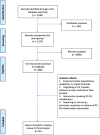A population-based approach to integrated healthcare delivery: a scoping review of clinical care and public health collaboration
- PMID: 31174501
- PMCID: PMC6556001
- DOI: 10.1186/s12889-019-7002-z
A population-based approach to integrated healthcare delivery: a scoping review of clinical care and public health collaboration
Abstract
Background: A population-based approach to healthcare goes beyond the traditional biomedical model and addresses the importance of cross-sectoral collaboration in promoting health of communities. By establishing partnerships across primary care (PC) and public health (PH) sectors in particular, healthcare organizations can address local health needs of populations and improve health outcomes. The purpose of this study was to map a series of interventions from the empirical literature that facilitate PC-PH collaboration and develop a resource for healthcare organizations to self-evaluate their clinical practices and identify opportunities for collaboration with PH.
Methods: A scoping review was designed and studies from relevant peer-reviewed literature and reports between 1990 and 2017 were included if they met the following criteria: empirical study methodology (quantitative, qualitative, or mixed methods), based in US, Canada, Western Europe, Australia or New Zealand, describing an intervention involving PC-PH collaboration, and reporting on structures, processes, outcomes or markers of a PC-PH collaboration intervention.
Results: Out of 2962 reviewed articles, 45 studies with interventions leading to collaboration were classified into the following four synergy groups developed by Lasker's Committee on Medicine and Public Health: Coordinating healthcare services (n = 13); Applying a population perspective to clinical practice (n = 21); Identifying and addressing community health problems (n = 19), and Strengthening health promotion and health protection (n = 21). Furthermore, select empirical examples of interventions and their key features were highlighted to illustrate various approaches to implementing collaboration interventions in the field.
Conclusions: The findings of our review can be utilized by a range of organizations in healthcare settings across the included countries. Furthermore, we developed a self-evaluation tool that can serve as a resource for clinical practices to identify opportunities for cross-sectoral collaboration and develop a range of interventions to address unmet health needs in communities; however, the generalizability of the findings depends on the evaluations conducted in individual studies in our review. From a health equity perspective, our findings also highlight interventions from the empirical literature that address inequities in care by targeting underserved, high-risk populations groups. Further research is needed to develop outcome measures for successful collaboration and determine which interventions are sustainable in the long term.
Keywords: Community health; Health equity; Population health; Primary care; Public health.
Conflict of interest statement
The authors declare that they have no competing interests.
Figures
References
-
- Frenk J, Chen L, Bhutta Z, Cohen J, Crisp N, Evans T, et al. Health professionals for a new century: transforming education to strengthen health systems in an interdependent world. Lancet. 2010;376(9756):1923–1958. - PubMed
-
- Institute of Medicine . In: Microbial threats to health: emergence, detection, and response. Smolinski MS, Hamburg MA, Lederberg J, editors. Washington: National Academy Press; 2005. - PubMed
-
- Commission on Social Determinants of Health . Closing the gap in a generation: health equity through action on the social determinants of health. Geneva: World Health Organization; 2008. - PubMed
Publication types
MeSH terms
Grants and funding
LinkOut - more resources
Full Text Sources
Medical
Miscellaneous


